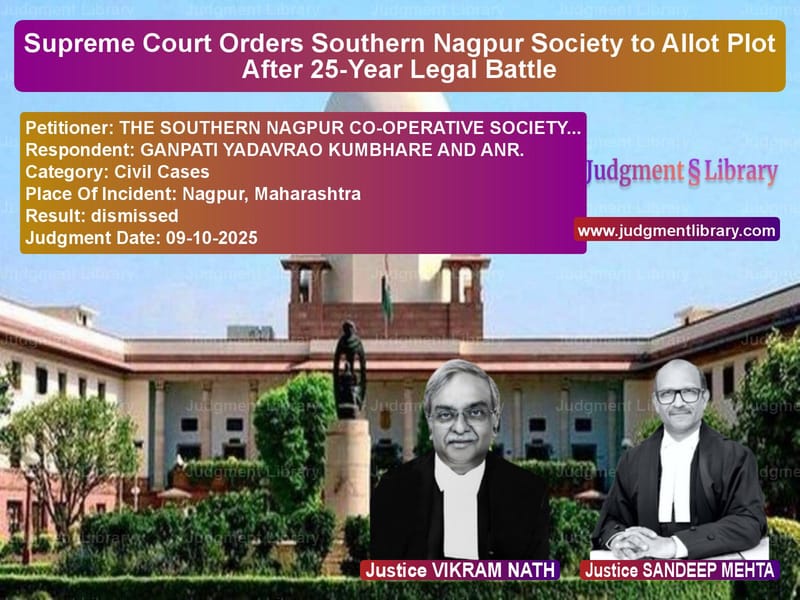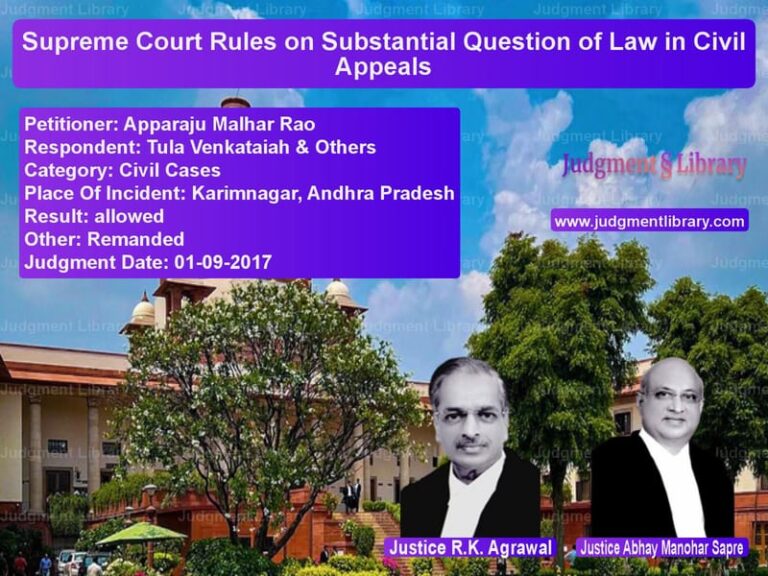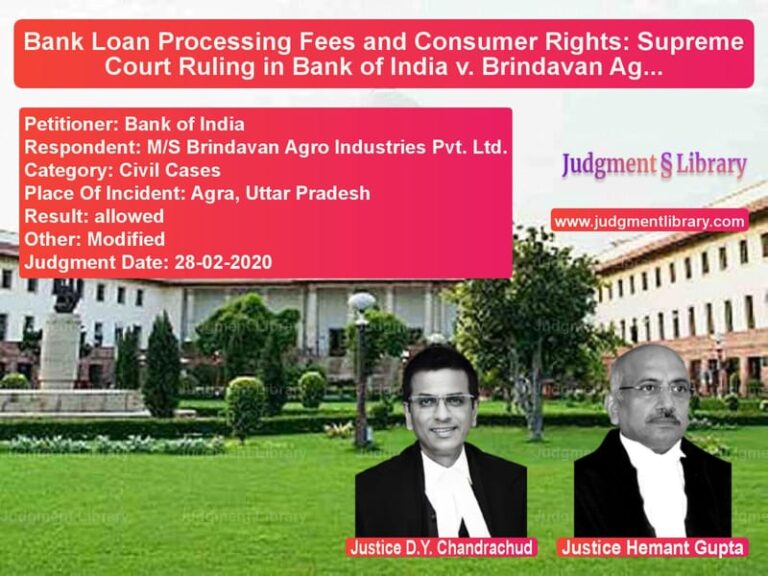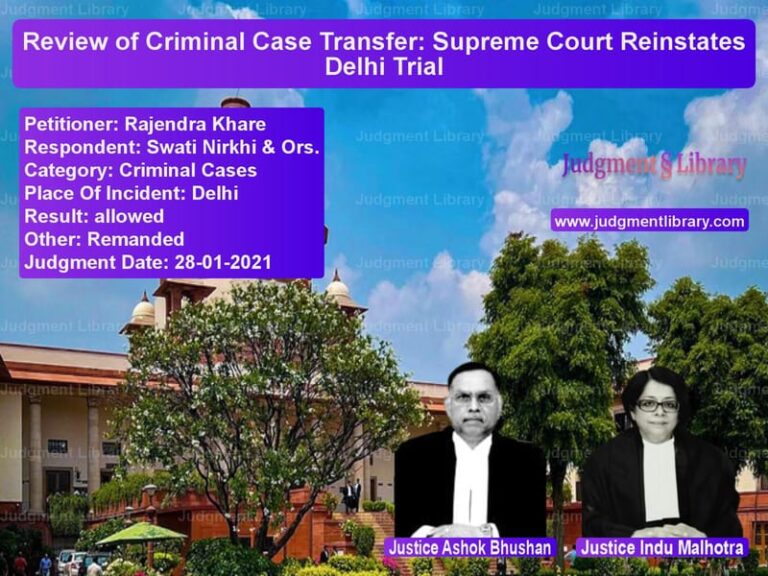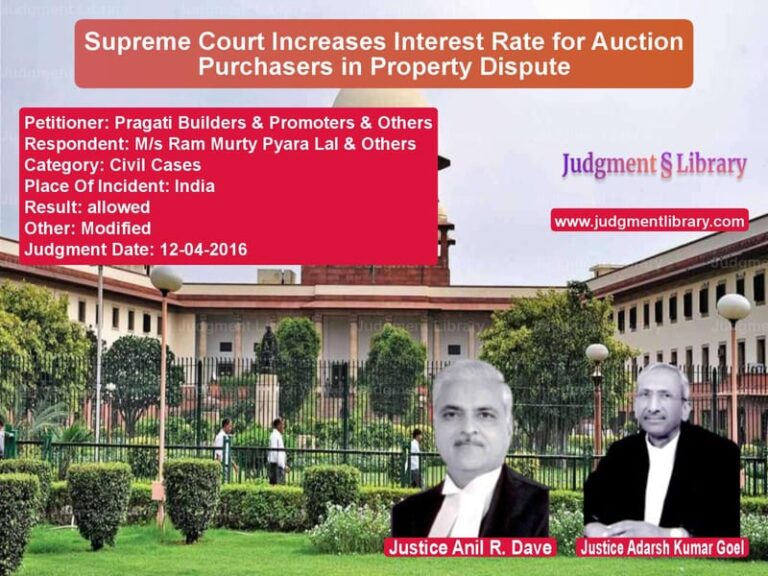Supreme Court Orders Southern Nagpur Society to Allot Plot After 25-Year Legal Battle
In a landmark judgment that brings closure to a quarter-century legal dispute, the Supreme Court of India has directed the Southern Nagpur Co-operative Society Limited to finally allot a plot to its member, Ganpati Yadavrao Kumbhare. The case, which began in 1991, represents one of the longest-running property disputes in recent Indian judicial history and highlights the challenges ordinary citizens face when dealing with uncooperative housing societies.
The dispute originated when Mr. Kumbhare, a member of the Southern Nagpur Co-operative Society, raised concerns about the allotment of plots within the society’s layout. Initially, he claimed rights over Plot Nos. 3 and 4, but through an amendment in 1996, his claim was shifted to Plot No.5A. What followed was a legal marathon that would test the patience of any litigant and the resilience of India’s judicial system.
The Cooperative Court in Nagpur, after considering all evidence, delivered its verdict on March 31, 2000, directing the society to allot Plot No.5A to Mr. Kumbhare. The society, unwilling to accept this decision, appealed to the Cooperative Appellate Court, which dismissed their appeal on April 20, 2002. Still not satisfied, the society approached the High Court through a writ petition, which was disposed of on October 7, 2006, with the court granting liberty to the society to raise objections before the Executing Court.
When execution proceedings began, the society raised a new objection – that Plot No.5A had lost its identity because it had been merged with Plot Nos.4 and 4A, and building plans had been approved by local authorities for the consolidated plot. Based on this argument, the Executing Court closed the execution proceedings on April 27, 2011, accepting the society’s position that the decree had become inexecutable.
Mr. Kumbhare then appealed to the District Court, which delivered a comprehensive judgment on October 16, 2015, rejecting the society’s objections for multiple reasons. The Appellate Court noted that “the objections that Plot No.5A had lost its identity having been merged with Plot Nos.4 and 4A were not raised before the Cooperative Court or the Cooperative Appellate Court,” and that “the merger of these three plots was never approved by the competent authority.” Most significantly, the court observed that “the alleged constructions were illegal and without any sanction of the building plans” and that “even if some constructions had been raised, they being clearly illegal were liable to be demolished and clear and vacant possession of Plot No.5A with its due area was liable to be allotted and handed over to the respondent.”
The society’s subsequent revision before the High Court met with even stronger disapproval. The High Court not only dismissed their revision but imposed costs of Rs. 25,000/- upon the society, finding their conduct and claims to be “frivolous and malicious.” This harsh characterization by the High Court indicated the judiciary’s growing impatience with what appeared to be deliberate attempts to avoid complying with a valid court decree.
The Supreme Court Hearing
Before the Supreme Court, the society, represented by multiple senior counsels including Mr. Shyam Divan, Mr. S. R. Singh, and others, advanced two main arguments. They contended that “Plot No.5A had lost its identity in 1985 much before the dispute was raised by the Respondent in 1991” and that “huge construction has been raised over the Plot No.5A which stood merged with two other plots being Plot Nos.4 and 4A and thereafter, transfers have been effected in favour of third parties by the Society as such the decree is completely inexecutable.” They argued that it was impossible to execute the decree since constructions had been raised according to law and couldn’t be removed when the transferees weren’t parties to the original case.
On the other side, Mr. Balbir Singh, representing Mr. Kumbhare, made compelling arguments. He asserted that “Plot No.5A is still available for allotment, sale and handing over of the possession.” He explained that “the small portion covering the Plot No.5A is only the passage which is a covered passage going to the community hall which can be very easily removed, and the Appellant can always find a frontage or access to the community hall leaving Plot No.5A intact.” He further argued that there had never been a valid merger of the three plots as claimed by the society, and all constructions were unauthorized since the local authority had rejected the society’s building plans. Most importantly, he highlighted that “as the value of the land has substantially enhanced, the Appellant is deliberately avoiding complying with the decree of the Cooperative Court and the Respondent has not been able to reap its benefits for the last 25 years despite the decree of the Cooperative Court.”
The Photographic Evidence
A crucial element in the Supreme Court’s decision was a photograph relied upon by both parties. The Court observed that “the photograph placed on record and relied upon by both parties clearly depicts that a substantial portion of the land in question remains open and unoccupied. It is observed that an open area exists towards the extreme left of the plot, while minor construction has been raised towards the right end of the said open space. The said construction appears to be in the nature of a covered passage providing access to the community hall.”
This photographic evidence became the cornerstone of the Court’s reasoning. The judges noted that “upon perusal of the record, it is evident that the existence and nature of this structure are not in dispute between the parties.” This admission was significant because it undermined the society’s claim that the plot had been completely developed and was therefore impossible to allot.
The Supreme Court’s Verdict
In its judgment delivered by Justices Vikram Nath and Sandeep Mehta, the Supreme Court firmly rejected the society’s arguments. The Court declared: “In view of the admitted position reflected in the photograph, this Court finds no justification for the continued existence of the said covered passage on the disputed land. Accordingly, it is directed that the said construction, not being integral to the main building, shall be removed forthwith. Upon such removal, the Plot No.5A shall be allotted and clear and vacant possession to be handed over to the Respondent.”
The Court also addressed the concerns of third parties who had intervened in the case, particularly shop owners who feared their establishments might be affected. The judgment provided clarity: “It is further clarified that the shop owners who have intervened in the present appeal shall not be affected by the present order. The said intervenors are occupants of shops situated on Plot Nos. 4 and 4A, and not on Plot No. 5A, which is the subject matter of the present proceedings. The direction for removal of the structure standing on Plot No. 5A and the consequent allotment and handing over of possession thereof to the Respondent shall have no bearing on the rights, interests, or possession of the said shop owners. Their existing occupation and enjoyment of Plots Nos. 4 and 4A shall remain undisturbed.”
Broader Implications
This judgment carries significant implications for cooperative housing societies across India. It sends a strong message that societies cannot arbitrarily deny members their legitimate rights to plots and cannot use delay tactics or create false impediments to avoid implementing court orders. The Supreme Court’s firm stance against what lower courts had termed “frivolous and malicious” conduct serves as a warning to societies that might consider similar strategies.
The case also demonstrates the importance of photographic evidence in property disputes. The clear visual representation of the actual ground situation helped the Court cut through complex legal arguments and reach a practical solution. The photograph showed that contrary to the society’s claims of massive development making the plot unavailable, substantial open land still existed, with only minor construction that could be easily removed.
Furthermore, the judgment highlights the judiciary’s role in protecting the rights of individual members against powerful collective bodies. For twenty-five years, Mr. Kumbhare fought against a cooperative society that used every legal avenue to avoid complying with a valid decree. The Supreme Court’s decision reaffirms that justice, though sometimes delayed, will ultimately prevail when litigants persist through the legal process.
The Court’s careful balancing of interests – ensuring Mr. Kumbhare gets his rightful plot while protecting innocent third parties who had established businesses on adjacent plots – demonstrates the nuanced approach required in long-standing property disputes where multiple interests have developed over time.
Conclusion
The Supreme Court’s dismissal of the society’s appeals brings to close a legal battle that has spanned generations. For Mr. Kumbhare, it represents vindication after twenty-five years of struggle. For cooperative societies across India, it serves as a reminder that they must act fairly and transparently in their dealings with members. And for the Indian judiciary, it demonstrates the system’s capacity to deliver justice even in complex cases that have stretched over decades.
The judgment reinforces fundamental principles of property rights and contractual obligations in the context of cooperative housing. It establishes that societies cannot unilaterally alter plot arrangements to defeat members’ rights, and that courts will intervene to prevent injustice when societies engage in obstructive behavior. Most importantly, it proves that no legal maneuver, however creative, can ultimately defeat a legitimate claim when pursued with determination through proper legal channels.
As Mr. Kumbhare finally prepares to take possession of Plot No.5A, his case stands as a testament to the resilience of ordinary citizens in their quest for justice and the ultimate effectiveness of India’s judicial system in protecting the rights of individuals against more powerful entities.
Petitioner Name: THE SOUTHERN NAGPUR CO-OPERATIVE SOCIETY LIMITED.Respondent Name: GANPATI YADAVRAO KUMBHARE AND ANR..Judgment By: Justice VIKRAM NATH, Justice SANDEEP MEHTA.Place Of Incident: Nagpur, Maharashtra.Judgment Date: 09-10-2025.Result: dismissed.
Don’t miss out on the full details! Download the complete judgment in PDF format below and gain valuable insights instantly!
Download Judgment: the-southern-nagpur-vs-ganpati-yadavrao-kum-supreme-court-of-india-judgment-dated-09-10-2025.pdf
Directly Download Judgment: Directly download this Judgment
See all petitions in Property Disputes
See all petitions in Contract Disputes
See all petitions in Specific Performance
See all petitions in Damages and Compensation
See all petitions in Landlord-Tenant Disputes
See all petitions in Judgment by Vikram Nath
See all petitions in Judgment by Sandeep Mehta
See all petitions in dismissed
See all petitions in supreme court of India judgments October 2025
See all petitions in 2025 judgments
See all posts in Civil Cases Category
See all allowed petitions in Civil Cases Category
See all Dismissed petitions in Civil Cases Category
See all partially allowed petitions in Civil Cases Category

